|
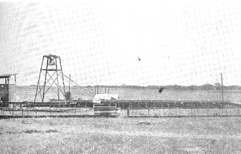
A view of the equipment used at Arbor State Park for the Coursing meets.
NATIONAL COURSING EVENT
From the Wymorean December 4, 1913 "At a meeting of the Wymore Coursing Association held at the Touzalin last Friday night, it was found that the National dog races held here in October cost the business men of Wymore just $173.00. Ten per cent of all subscriptions will be collected, which will pay all expenses of the meet, and will allow a surplus to fix up the ball grounds in Arbor State Park, which were destroyed in making a coursing field.
"Total receipts from the Coursing Meet were $2,257.18. The largest single item of expense was for work on the grounds. Rabbits cost about $880 00"
Later issues carried the list of officers which included Leo Holmes as treasurer. The second National Coursing Meet was held April 16-17, 1914.
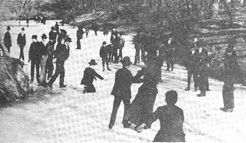
Ice skating on Indian Creek n the early 1900's. Are you there? |
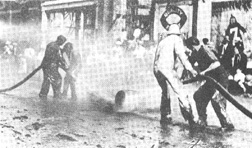
Water fight July 4th, 1916—great sport when Wymore streets were dirt. It seems that water and dirt mixed together makes mud.
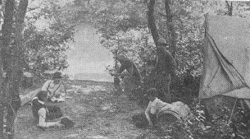
Here we have a sport that is called "just plain relaxin' along the Blue." The general rules of this game haven't changed much over the years—"just be comfortable."
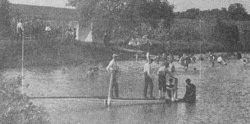
No swimming pools then! Those who enjoyed swimming did it in the river or the creeks. Note the tent, apparently used as the dressing room. |
 |
| | 31 |
|
 |
The thirties issued into the realm of football a new era—color and speed were the factors in the greatest demand. There was a young coach fresh out of Wesleyan University by the name of Al Gembler who brought state recognition to his Wymore football and basketball teams as Wymore football teams were in contenton for "mythical state championship" three years in a row, playing some schools larger by many times over in student enrollment, Lincoln High school of Lincoln, Jackson High of Lincoln, Havelock, and of course Crete under the tutelage of 'Pop" Klein, to name a few.
This picture shows one of Gembler's teams, 1930, second row left to right Al Gembler, coach; Jack Hamer, halfback; Logan "Puss" Neuman, fullback; Bob Punches, center, Dean "Hippo" Chase, tackle; Dorsey, end, Leo Holmes, Jr., halfback; Jim Keck, tackle. Front row, left to right: Lawrence Danforth, quarterback; Joey Punches, guard, Floyd "Nick" Antram, quarterback; Harry "Mose" Pisar, guard, Dwight "Snooker" Jones, end; Karl Fulton, end, Jack Mishnick, guard; McNulty, back; "Squeek" Kelly, student manager. Nick Antram was voted All State quarterback first team 1930 and 1931. Dean Chase voted All State tackle first team 1932. |
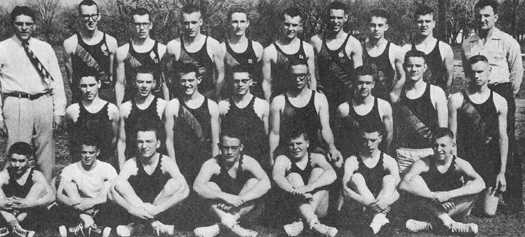 |
The Wymore Zephyr track team brought honors to its school in the spring of 1956 by winning every track meet they entered, including the Doane Invitational, the Conference at Hebron, the Auburn Relays, the Wymore Invitational, the District meet in addition every school record were broken except for the pole vault, discus, shot and 880 relay.
Members of the squad shown above are left to right, front row David Savener, Jick Keck, Jim Heble, Butch Miller, Bob Poutre, Lowell Robson, David Robson. Second row Charles Johnson, Jim Chapp, Mike Donavon, Dennis Adee, Ted Schafer, Brendan Mallam, John Benson, Jean Henrichs, Jr. Third row Coach Bill Hladik, Dave Philippi, Larry Wood, Gail Miller, Ron McKeever, Jerry Marples, Jack McCracken, Clark Mallam, Larry Brown, Coach Jim Mather. |
 |
| 32 |
|
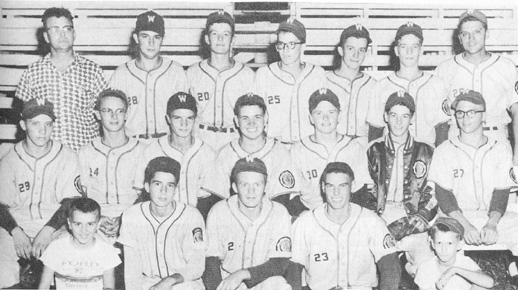 |
For several summers the American Legion, assisted by the Chamber of Commerce and the City, have promoted American Legion and Midget baseball teams along with the summer recreation program. In 1954 the Junior Legion team won the district and area tournaments in Class B held in Wymore but were eliminated in the State tourney also held here. In 1955 the team was eliminated in the Area tourney, all three again being held in Wymore.
Members of the 1954 team pictured above were, front row, left to right: Larry Snook, batboy; Dick Arnold, LeRoy Guenther, Jock McCracken, Ricky Wood, batboy. Second row. Gary Baker, Walt Henrichs, Ron Powell, Ron Snook, Budge Heusman, Clair Duensing and Ted Schafer. Bock row: American Legion Athletic Officer Mel Andres, Paul Cody, Kenton Wrightsman, Larry Wood, Jerry Marples, Rich Ideus, Coach Bill Hladik. |
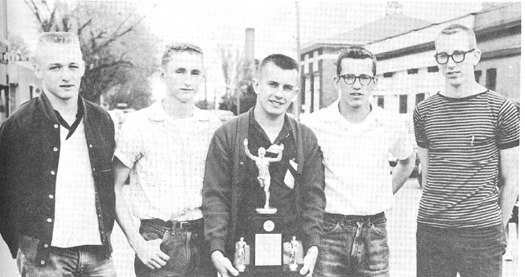 |
Qualifying for the State Track Meet in the Spring of 1956 were the five shown above. Left to right, Gale Miller, Ronald McKeever, Jerry Marples, Larry Wood and Dave Philippi. At the end of the meet the boys were awarded the first place trophy, the first time the Zephyrs had won a state meet in the history of the school. Marples placed first in the 800-yard run. Wood placed first in the broad jump, 100 yard dash, tied for 4th in the high jump, and 3rd in the 220 yard dash. Philippi placed 5th in the low hurdles. The mile relay team composed of McKeever, Marples, Wood and Philippi placed 2nd. |
| | 33 |
|
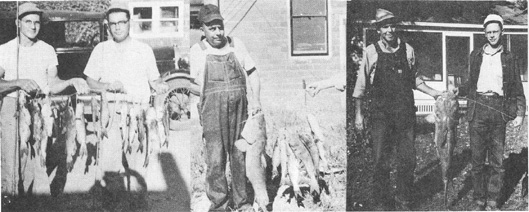 |
Fishing in the Blue isn't what it used to be, according to old timers, but there are still huge numbers of fish caught each year. These pictures were taken at random from The Arbor State files the past few years. At left Howard Gore and P M Everson, center is Roy Shores. and right are Earl and Jack Mathews. |
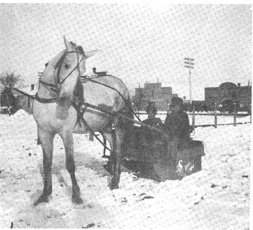
Sleighing has always been an enjoyable pastime, as to its competitive qualities we remain mum, but we do know that it was great fun. In this early day photograph you are looking northeast over the lot where later the Julius Neumann building was built. That would place this picture has having been taken sometime before 1901. | 
by Karl Fulton
Names we remember and receive a touch of nostalgia like going into Herb Lippolds and buying a sack of cookies, or on up the street and buying some of Tony Herman's hot "bologna," and later on when "Bill" Jones took over Tony's market he continued to make it and Lou Burkhalters place where you could get the finest candies, pastries and ice cream anywhere in the whole wide world. There was Pacal's Clothing Store, Hargraves, and Lasher's Hardware Store where we'll wager a lot of us bought our first pair of ice skates, and later when they got dull took them over to Herman Kessler and got them sharpened. And how many of us saw our first motion picture in the "old" Lyric, or later on down the line our first "talkie" at the Markle theatre? And how about you old timers when they showed the first movies over at the Opera House? Were you there?
How many of you ever bought maple sugar patties in Douds or later when S. D Cole took over the store? And Holmes' Bakery where we could get the most luscious pecan rolls that ever melted in our |
 |
| 34 |
|
mouth, and they tell us that Leo served a pretty fair country meal when he 'had his restaurant "away back when."
We can stroll up memory lane with many names up and down main street—there's Millers, Adkin Bros. Furniture, Howe Hardware, and can you hear the blacksmith hammers in the background, there are several of them working at the same time. Before the welding rod was ever heard of, the blacksmith plied his trade as improvisor in iron and metals, he was engineer, inventor, from plow shares to girders and don't forget the horses he was the shoe shop for them all. To watch Lett Wymore work at his forge was sheer joy for us youngsters and to smell the red hot horse shoe applied to the horse's hoof was an odor we'll never forget. Besides Lett Wymore's Shop there was Coleman's Blacksmjth Shop and before them Brown's Blacksmith Shop.
On up the street of memory we come to Cases Ice Cream parlor, Wright's Cleaners and Raske Cafe. Some of the finest Monday morning quarterbacks in town would congregate in "Neezer" Wuester's shop and discuss merits and demerits of anything from the Democratic party to Babe Ruth's batting average, there were the Hughes Bros. shop, Long's Barber shop, Schwentker Shop, and we'll wager not a few will ever forget "Dusty" Rhodes."
Recreation parlors to some, pool halls to others, by any name provided pleasant pastimes to many who took up the fine art of making billiard balls roll across a felt padded table at the intended direction of the director at the end of a cue stick and for this reason a hall is organized with the proper equipment were challenger can meet the challenged. Such a place was Bill Riggs, also Scheideler's and Hemperly's. On up the street there was C. J. Werner's Tin and Plumbing shop and Ed Ray's Harness shop. There was Mrs. Schad's flower shop, across the street was Herman Trauernicht and Frank Herman's Cornhusker garage. Remember the Owl garage and as youngsters we repeated an oft used phrase "It sure would hold a heap of hay" and in the twenties as bare foot youngsters we would view in awe George Coffey's new Chevrolet cars on display and declare they just couldn't ever make a prettier or more powerful car than those shiny new Chevrolets of those bygone days.
We like to recall drug stores and the many and varied scents that assailed our nostrils from the many herbs and totally mysterious medicines that were concocted there and how many of you as youngsters
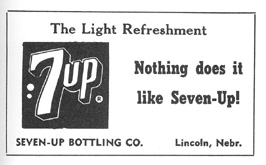
| would heckle the druggist for a nickle's worth of licorice root or anice oil and cinnamon oil to dip tooth picks in and touch to your tongues, and how dependent the old folks were on the ever present camphor bottle. We can recall that when we would enter the environs of the Hill and Schafer drug store it was always cool in the summer time, and the Youll Drug Store across the street from Schafer's always gave us the biggest ice cream cone in town.
And the grocery stores! We were in and out of them like fleas. Dave Singer's store, Koenigs, Safeway, Okers, Carrie Hines, and Bill Jones. The banks standing like monuments to high finance in our young minds dealing in infinite figures with dollar signs attached, and when they would publish their annual report why did they bother to mention the two cents at the end of their capital and assets when all it could buy was two licorice sticks down at Herb Lippold's candy counter and so it ran in our young minds. There was the Wymore First National where we could always tell the time of day and get weighed free and also get a drink of water out on the street corner, and the Farmers and Merchants bank we can recall vividly, the air being punctuated by the sound of gunshot reports when it was "held up" by bank robbers, it stimulated our ferver in that ever popular game of "cops and robbers."
Hotels, The Cadman, The Vendome and as kids we were always being reminded that it was in the "old days" known as the Touzalin. There was the City Hotel on down by the Depot. Fulton's Monument Shop provided many a curious hour when the staccato of the air hammer that was used for the lettering of the granite and marble droned on in the lazy heat filled summers and it was always silent curiosity for a conversation was never necessary and would have gone unheard anyway. And when we were not going barefooted in the summer time there was what seem-
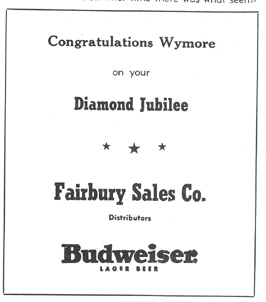
|
| | 35 |
|
ed a constant repairing of our shoes and that burden fell on either Mamie Turner or Darnold's Repair Shop which ever was the closest to our mishaps.
As kids we stood in awe of our famous healer Perry Philben, we would repeat some of the fabulous stories of his noted powers of healing, and if sly enough would invent some that even he had never heard of, but for the most part our conjecture would dwell on "what is his power?" I can't recall if we ever come up with an answer but it was an never ending source of wonderment. But this we did know that there were thousands of people who came to his door for relief and we also know that a great many went away as completely satisfied with relief from their pains and ailments.
I have gained many happy experiences from my wanderings up and down the main streets of Wy-more, from following in the wake of the water wagon barefooted on a hot summer day, to settle the dust of the dirt streets, until later years when I was too proud to go barefoot on Saturday night when we would find Lou Hohensee, the publisher of the Weekly Arbor State, conducting the Saturday night band concerts.
And speaking of going barefooted, there was the time Dr Thomas sewed a severe cut on my foot from a broken milk bottle, and when I remember Doctors it was Dr. Peters who gave me my first introduction to the use of "shots" for Diphtheria, Typhoid, Small Pox and they must have worked because I never recall having any of those things. Dr. Fritz filled my first teeth and Dr. Hinman worked on a few of my molars (at least I think they were molars), I never quite made it in to Dr. Feese. The other two dentists by this time knew of my cowardice and aversion to dentists and I figured that was a sufficient number of citizens to be in knowledge of my short comings. However if I had my shortcomings in the
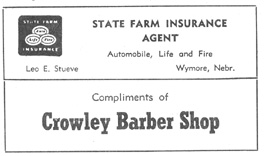
|
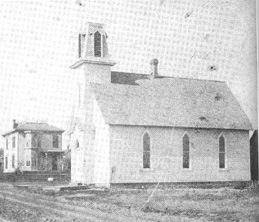
Towns and people change. This Baptist Church stood on the corner of 9th and F streets in 1888, now a vacant lot. Across the street west was the Greenwood home, now owned by Larry McNulty. The church building was later moved to North 11th street and converted into a residence.
matter of not standing pain I wasn't wanting for them on Halloween night. It always seemed that I was the one that was found out for my bravery on that night and would have to make restitutions by apology or other means at the suggestion of our chief for police "Bill" Kelley, I knew him to be a proficient policeman, gendarme, menien of the law, as it were. Whereas I can remember the enforcers of the law, I remember too the interpretors of the law in our two attorneys at that time. "Jim" McGuire stands out in my memory for having heard him, at various times, extoll the virtures of the Democratic Party, Cloyde Ellis I remember for the resonance of his voice as I had heard him speak on different occasions at several of our High School banquets and functions. There are many things that one forgets from out of the past, and they well might be important things, momentous occasions, names, places, conditions and it could easily be interpreted that by their ommision, as an oversight, that they are today unimportant. This in my recollections is not the case, for as a child I watched the brick layers, laying brick by brick, the main street of our Wymore. It didn't even then, occur to me to ask "how many bricks in the whole street," |
 |
| 36 |
|
|
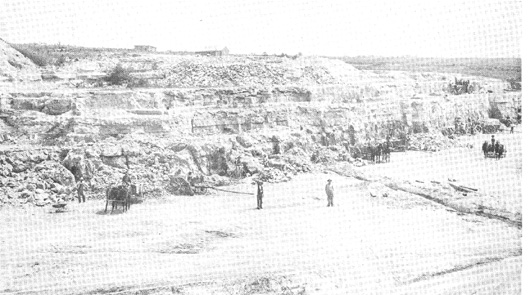 |
THE DAVIS QUARRY
In 1902, local newspapers reported the Days & Mayne rock quarry, later known as the Davis quarry east of Wymore, was turning out an enormous amount of work with over 100 men on the payroll Over 400 cars of stone have been shipped from the quarry this year, an August 18 publication stated.
Mentioned in particular was a single stone cut at the quarry. It was 54 feet long, 4 feet wide and 1 8 inches thick. It was cut so it could be handled and placed on a car for shipment, | making a good car load.
In 1912, payroll at the Davis Quarry amounted to $19,933.07 and 827 car loads were shipped that year.
With the demand for building stone replaced by brick, the quarry has produced rood material on a small scale during recent years, except during World War II when hundreds of cars of crushed rock were shipped to the Naval Amunition Depot being built at Hastings. Ground rock is now being used from the quarry to lime farm land. |
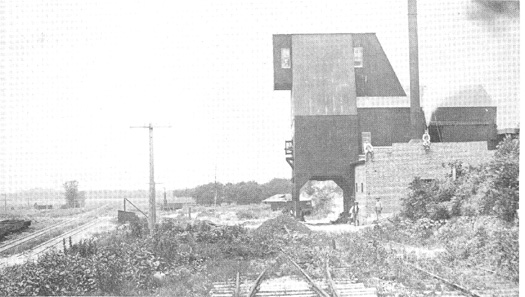 |
| | 37 |
|
|
WYMORE NEWSPAPERS
From "The History of Gage County, Nebr., 1918"—Wymore appears to have always been an inviting field for newspaper men. In May, 1879, Charles M. Murdock had established at Blue Springs a newspaper called The Reporter, largely an advertising medium for the sale of real estate, but on the 22nd day of June, 1881, he removed his printing establishment to Wymore and thereafter for many years the Wymore Reporter was an important factor in the settlement and development of that city. This was the first newspaper in Wymore.
In May, 1 881, Joseph R. Dodds, a veteran of the Civil War, came from Burlington, Iowa to Wymore and immediately became active in its affairs. He erected the two-story brick building on the corner of Nebraska street and Blue River avenue, directly south of the Touzalin Hotel, where later the Citizens bank was established. On the 12th day of May, 1 882, from the basement of this building, Mr. Dodds sent forth the first issue of the Wymore Eagle. In the fall of that year he purchased from Ashby & Scott the Gage County Leader, a newspaper which had been founded shortly after Murdock had brought the Reporter to Wymore, and this he consolidated with The Eagle. A little later he merged both into the The Democrat, bearing the following legend "Wymore and Blue Springs." Before his death he ceased publishing the Democrat and began the publication of The Arbor State
John A. Weaver, a practical newspaperman, came to Wymore from Red Oak, Iowa in 1882 and in conjunction with J. M. Burnham established The Wymorean. Mr. Weaver withdrew shortly afterwards and Burnham published the paper until his death March 30, 1929. The paper was then published by his son Earl Burnham and in 1934 was sold to C. L. Peckham who combined it with the Blue Springs Bee. Later moved to Wymore, it was combined with the Arbor State in 1946.
J. W Ellingham succeeded Dodds as publisher of The Arbor State in 1907. In 1919, he sold The Arbor State to Mr. and Mrs. Lou Hohensee. In 1920, a half interest was sold to Walt Cook and in 1922 Cook sold his half interest to Oscar Green. In 1925, the Hohensees purchased Mr. Green's interest in the paper.
The Hohensees published The Arbor State until 1937 when they sold it to Albert Higgins of Linn, Kans. about six months later he sold a half interest
| 
Another view of Wymore's main street though the date is not established. However the high wheeled wagon in the foreground establishes it as back in the early days. It appears the town then had cement sidewalks which even crossed the dirt streets.
to J M Crane of Clifton, Kans. A few months later Mr. Crane purchased Mr. Higgin's interest and published the paper until September 15, 1941 when it was sold to Earl A. Funk of Golden, Cob, who continues as publisher and editor to this time.
In recent years, the plant has been expanded to enable it to handle a large volume of printing. Customers are served in several states. This summer Offset Lithography was added to the letter-press facilities to enlarge the field of printing which the shop can handle.
CEMENT SIDEWALKS
The following article was taken from the June 23, 1 904 issue of The Weekly Wymorean.
"A company has just been formed to manufacture concrete building blocks, sidewalk blocks and kindred products in the city of Wymore. The machinery has been purchased at a cost of $690.00 and will be shipped next Monday, and samples of the work will be on exhibition within the next two weeks. The company is authorized to issue stock to the amount of $10,000.00 which may be increased at any regular meeting of the stockholders. Enough stock has been taken by the incorporators to start the plant and no more will be sold at this time. It is the intention of the incorporators to extend the business |
 |
| 38 |
|
until they can manufacture their own cement, make sidewalk brick as good as are now made at Table Rock and all at a cost within the reach of the people. They will make sidewalk blocks that will lay a sidewalk far superior to brick and at half the cost; and they can furnish a stone far superior to anything that can be quarried anywhere, in fact, this industry is flourishing in Indiana where they have the finest building stone in the world Do not be in a hurry about putting down new sidewalks until you see the new material and lay your walk out of a substance that does not hove to be shipped in and that will stand as long the the Pyramids of Egypt. The enterprising gentlemen who are backing this great undertaking are all residents of Wymore, and believe in working for Wymore. The name of the new company is "The Wymore Concrete Company."—A. D. McCandless,
The following article, pertaining to cement sidewalks, was submitted by Hal Vance' "The Wymore Concrete Co. organized in June, 1904, to manufacture block and concrete sidewalk brick. The incorporators were A D McCandles, lawyer; Geo Stevenson, insurance agent and Silas S Spier, State Representative They opened for business with Chas Vance in charge of operations At that time nothing was known of the manufacture of cement and concrete in this locality and Mr Vance had to write to the Congressional Library of Washington, D C for literature on the subject After several years of operation the company disbanded and Mr Vance took over and ran the company for a number of years At one time he had built over 8 miles of sidewalk in Wymore, including most of the sidewalk on main street, some of which lays there today Among the other things built of concrete by this company were the cement fence along the front of the cemetery, the Geo Stevenson residence at 12th and H Street, and several other houses. Most of the cement walks in Wymore at the present time were bid by this company, many or most of them 50 years of age which speaks well for the durability of the concrete for construction."
We quote from The Weekly Wymorean of August 11, 1910:
"Chas Vance was awarded a contract to construct all cement walks ordered built by the city at a price of 9 cents per square foot. The contract calls for 5,088 feet of walk."
NEW STREET LIGHTS
From The Weekly Arbor Stote, Oct. 27, 1911: "The new street lights were completed last evening and current turned on for the first time in the business section of town. It gave the street a real citified appearance.
"There are three lights on each pole, one top and one on each end of a horizontal arm. Each light is about 60 watts; 100 candle power tungsten, cover-

|
ed by a white globe. The poles are cast iron, 9 feet high, and painted a brewster green. The lights on the arm are so wired that they may be switched off from the power house independently of the top one, and they can be switched off after business hours while the others are left burning."
ELECTION CELEBRATION
Taken from The Wymorean Nov. 21, 1912: The people of Wymore and Southern Gage county ratified the election of Wilson and Marshall last Saturday with a rip roaring old time political celebration. Two beeves were roasted and served with bread and coffee to all who came from three stands on main street.
A. D McCandless of Wymore made the principal address. He was introduced by James McGuire. The parade which came about 3 o'clock was the hit of the day. Then came a democratic mule colt, with Uncle Sam next, followed by the Blue Springs band. Next came a float pulled by eight mules. There were eight girls who sang and Charley Ripley and John McCarty furnished fife and drum music. Then came two wheelbarrows in which winners of erection bets were wheeled by bad guessers The fire department came next followed by a float entitled, "The Only Live One." On this rode the Wymore Bull Moose, without horns and lying on its side. Next in a carriage came a lot of fellows dressed in women's clothes, carrying banners telling of victories of woman suffrage in various states. Next a very cleverly made G.O.P. elephant ridden by a boy in a Boy Scout uniform. Then came the water wagon representing the prohibition party. Two hounds represented Champ Clark's lost cause. At dark the bull moose and the elephant were burned upon a big pile of barrels and boxes, and hundreds of Roman candles were shot off. The festivities lasted until far into the evening.
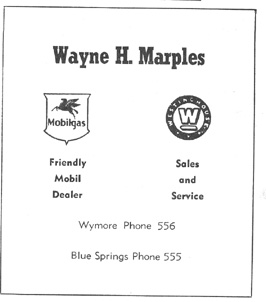
|
| | 39 |
|

